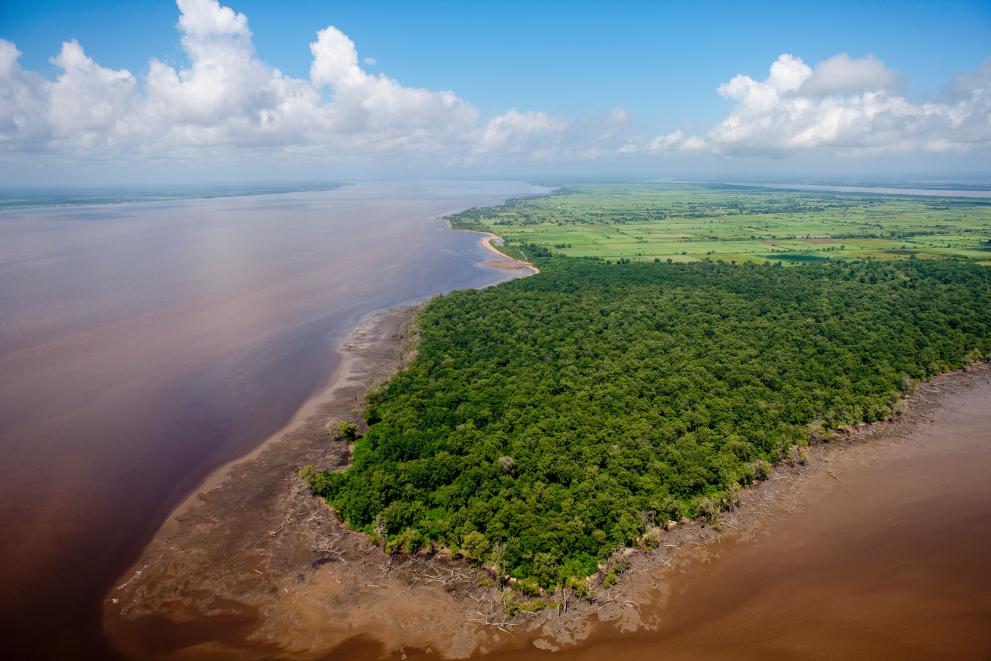
The Paris Agreement set as a global target a temperature which will not exceed by more than 1.5°C the one of pre-industrial times. However, according to a recent study published in Nature Sustainability, even if we commit to the above target, coastal flooding along vulnerable island nations could still increase more than tenfold by the end of the century, compared to today.
Collectively, Small Island Developing States (SIDS) represent a group of 39 countries in the Caribbean, East Atlantic, and Pacific and Indian Oceans, and are home to about 70 million people. For many of them, the remoteness, limited resources, and fragile land and marine ecosystems make them particularly vulnerable to climate change as they lack economic alternatives. And some of them are among the world’s least developed countries.
The countries at greatest risk from coastal flooding include Guyana, Turks and Caicos Islands, the Marshall Islands, Guinea-Bissau, Suriname, Kiribati, Belize, and Tuvalu. However, all SIDS need new forms of adaptation to protect their people, land, and economies – such an approach calls for rapid and continuous international support, including by harnessing of both public and private climate finance.
While some studies in the past have focused on quantifying the vulnerabilities of SIDS to climate change, many of these assessments have been limited to specific regions or lacked a global perspective. Filling the gap, this study by the European Commission’s Joint Research Centre (JRC) provides a panoramic view of coastal flood risks in SIDS and integrates state-of-the-art global modelling tools and datasets to provide robust insights in terms of cost, land loss, and population exposure.
Cost impact
The economic cost associated with sea-level rise is significant in SIDS. At present, the estimated annual damage of coastal flooding amounts to €1.54 billion ($1.69 billion) for all SIDS combined. These costs include direct damage to buildings, infrastructure, and agriculture from coastal flooding.
By mid-century, without adaptation, the annual damage of coastal flooding is projected to increase 9 to 11 times the present-day damages; to values which vary from 1.2% to 5.1% of the today’s SIDS GDP, depending on the emissions scenario. By the end of this century climate change would amplify present direct economic damages from coastal flooding by nearly 25 times under high-emissions scenarios.
Keeping global warming below 1.5 °C could avoid almost half of the unmitigated damages, depending on the region. Achieving this climate target, however, would still not prevent several SIDS from suffering economic losses. This economic burden would further strain the already limited resources of SIDS, e.g., preventing sustainable economic development and progress on the UN Sustainable Development Goals.
Land loss
Coastal flooding also causes land loss, which in turn has significant implications for communities and ecosystems that rely on coastal areas for their livelihoods and survival as well as way of life. Coral reefs and mangroves are crucial for many SIDS, as they act as a natural protective shield for the coasts. However, their protective function is under threat, especially in the face of global warming.
While the study is cautiously optimistic about the resilience of these ecosystems, any deterioration could mean that future coastal flooding risks to SIDS are underestimated.
Population exposure
Perhaps the most concerning aspect of sea-level rise for SIDS is the exposure of their populations to coastal flooding. While currently around 118 000 SIDS inhabitants are exposed to coastal floods, this number is expected to exceed one million by the year 2070, even if we achieve the Paris Agreement goals. This exposure not only puts individuals' lives and well-being at risk but also exacerbates the social and economic vulnerabilities of these nations.
Way forward
The study emphasises the urgency expressed by SIDS in global climate dialogues and that "doing nothing is not an option". Even with stringent mitigation measures, flood risk for SIDS is set to rise exponentially to unsustainable levels. The socio-economic implications could be severe, necessitating diverse adaptation strategies, from fortifying defences by introducing innovative nature-based solutions, to considering potential retreats from the most vulnerable areas.
The study underlines the urgent need for mitigation/adaptation for this century, but also reports that coastal flooding damages will keep rising beyond the 21st century. Adaptation measures, though crucial, face hurdles like limited resources, governance challenges and the limited institutional capacities in SIDS. The path forward requires not just science but political resolve and technical and financial resources.
Background
The EU, its Member States and the European Investment Bank are together the world’s biggest contributor of public climate finance to developing economies, providing €28.5 billion in 2022. The EU is also the world’s top provider of official development assistance – a total €70.2 billion in 2021 – with action to combat climate change being increasingly integrated into this assistance.
As a global leader in climate action, the EU recognises the unique challenges faced by SIDS. It has been at the forefront of providing financial, technical, and capacity-building support to these nations. Its dedicated programmes aim to bolster resilience, support sustainable development, and ensure that SIDS are not left behind as the world grapples with the effects of climate change.
The European Commission’s Neighbourhood, Development, and International Cooperation Instrument (NDICI) – Global Europe will channel the majority of the Commission’s funds for external action, and it is the EU’s main tool to contribute to eradicating poverty and promoting sustainable development, prosperity, peace, and stability. With a total budget of €79.5 billion between 2021 – 2027, the Commission has committed to spend 35% of the NDICI – Global Europe funds to support climate mitigation and adaptation actions in EU Partner Countries.
Related links
Small Island Developing States under threat by rising seas even in a 1.5 °C warming world
Details
- Publication date
- 5 December 2023
- Author
- Joint Research Centre
- JRC portfolios




